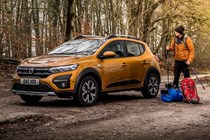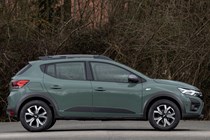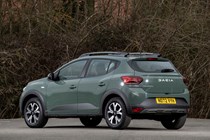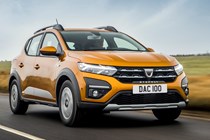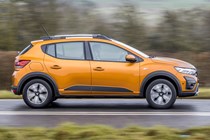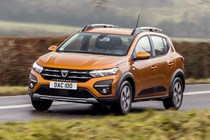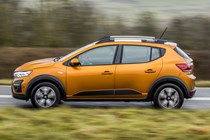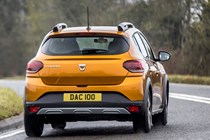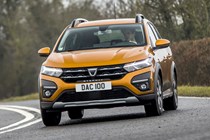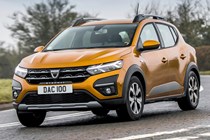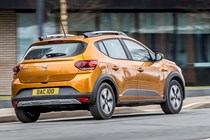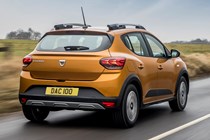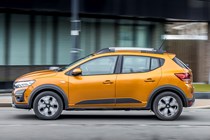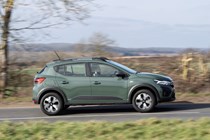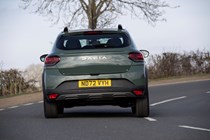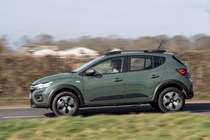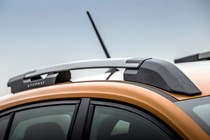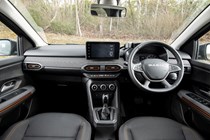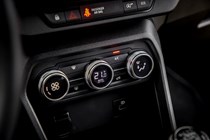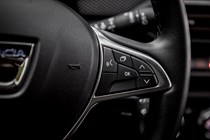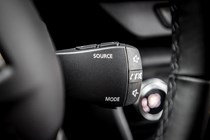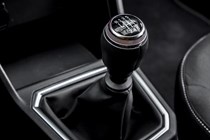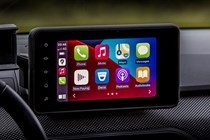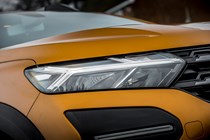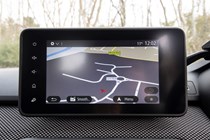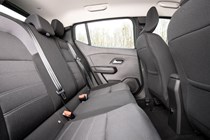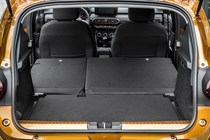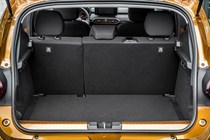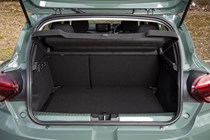Dacia Sandero Stepway long-term test
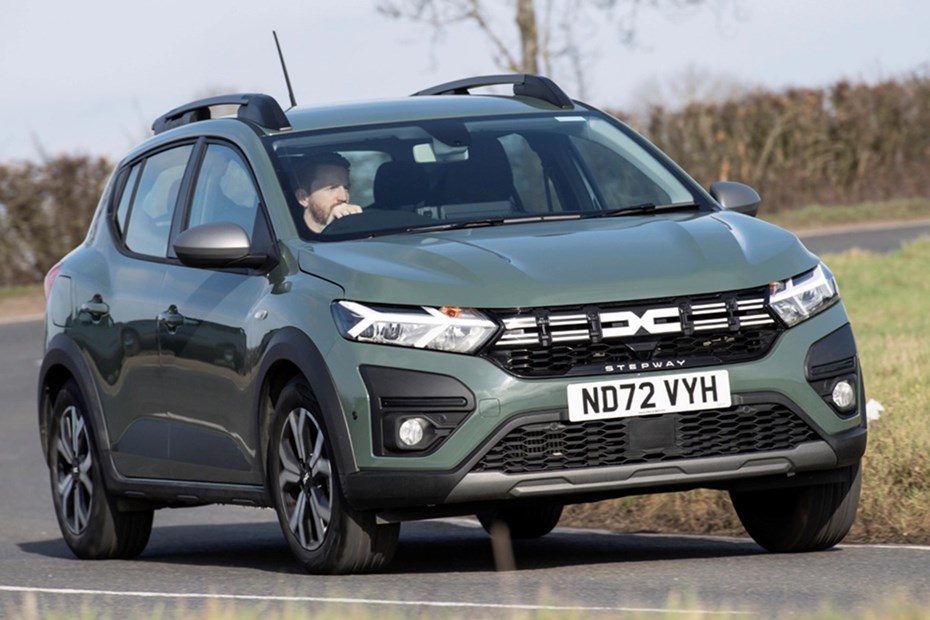
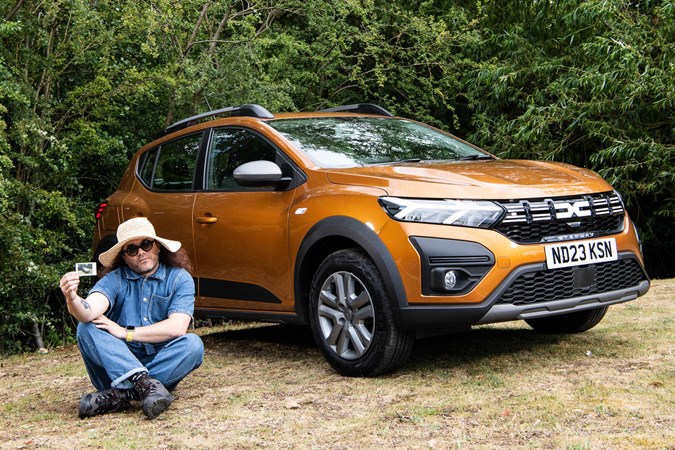
You know that grass-roots musician you love, who gets a private jet and sells fans ‘collectors’ edition’ overpriced remasters when they find success? Nearly all the ‘budget’ car brands you can think of in the UK have done this – and lost their authenticity in the process. But not Dacia.
Reports by RT ‘Bear’ Kilpatrick
The Romanian marque has doggedly defended its ‘most affordable cars in the UK’ territory, and in a period where inflation, cost of living and wage stagnation have become an almost universal problem, Dacia suddenly feels incredibly relevant.
And Dacia has little competition here. Unlike say, Skoda, Dacia has not added loads of upmarket, high spec models and lost that original brand territory; the only car that is comparably affordable is the MG 3.
Update 1: Introduction
Is it really necessary to spend more on a new car?
When it landed in the UK in 2013, Dacia’s Sandero was crude, but solid. The bare-bones Access model underlined how much had been stripped out, but few buyers needed to make those sacrifices and it’s no longer part of the range. Even with the second generation’s higher-quality build and trendy styling, this jacked-up, rugged-looking Stepway is markedly cheaper than most cars of comparable size and performance.
2022’s facelift and new logo swaps ‘budget’ for ‘futuristic-functional’ in the marketing and image, but not the price list. As such, the Sandero Stepway looks hard to beat.
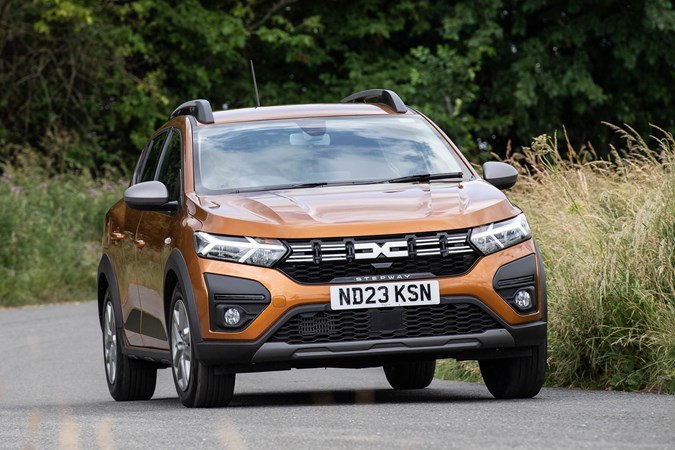
A glance at the spec sheet shows there’s obviously stuff missing compared with many superminis (notably lane keeping, which hits the Euro NCAP score of the otherwise tough, modern underpinnings shared with Renault and Nissan), but does ditched content mean discontent for Dacia buyers? How many drivers use all of the extras loaded onto the average car as part of a package to get one useful feature?
Stepway Expression – good enough?
We’re running the mid-spec Sandero Stepway Expression (£16,295 as of May 2023), which sits above the Essential and below a fully-loaded* Extreme model. Compared with the standard Sandero, the Stepway has a six-speed gearbox and 39mm more ground clearance, but otherwise is pretty much the same car: Extreme spec doesn’t offer the vibrant orange of our test car, but features a few extra gadgets and upmarket trim tweaks.

Options are limited, and the only extra cost on ours is £590 for non-standard paint. Stepway Expression includes the ‘Media Display’ (a smartphone mirroring 8.0-inch touchscreen with DAB radio, and snap-grip cradle to hold the phone), the modular roof rails that can be detached and installed across the roof as a rack, and manual air conditioning.
Of the Extreme’s kit it lacks, only the enhanced traction control and automatic air conditioning really appeal to me; alloy wheels are just another thing to damage and electric handbrakes seem pointless on a car this small and simple, but digital climate feels modern and upmarket as well as being nicer to use.
Urban warrior, motorway worrier?
Although the Stepway’s little three-cylinder engine sounds underspec after driving a 200hp Fiesta ST and generally favouring big, lazy mile-munching cars, it’s proven extremely capable over the first few hundred miles. It’s great in town, bounding over speedbumps and stress-free on rough roads particularly as it has cheaper plastic wheeltrims to think about, and it’s more than capable of feeling rapid – the 90hp isn’t carrying much weight and it’s well-geared.
Hit the motorway, and the surprise is how accomplished the Sandero is at handling British long-distance tedium as well as it does towns and country roads. It’s quiet generally, and the revs are kept down in sixth gear – there’s enough power in reserve for overtaking if you change down, at least when it’s just the driver on board. Standard cruise control is useful, and while there’s a lack of driver assistance the Stepway is so small, with generally good visibility and responsive controls, that you don’t miss such things and just settle into the rhythm of driving.
Fuel economy is consistently in the mid-40s almost regardless of driving technique, so far, and a generous size of fuel tank means plenty of time between stops.
CarPlay won’t play – at first
First impressions count and the Stepway did let itself down in one area – the sound system. I cannot stress how much I value this aspect of a car, and it doesn’t have to be high tech (my old Volvo has a tape deck) but it has to work as expected.
In theory the Stepway’s Media Display is more than enough. It supports Apple CarPlay and Android Auto (though Dacia dropped wireless support on the Media Nav models), but for the first couple of weeks I any attempt to use the iPhone for nav or music resulted in three minutes of success, then disconnected. Usually mid-song, mid junction or mid-drive.
I tried the original Apple cable, three known-good and two new purchased ones before solving the issue by buying an MFI (made for i-things – it did mean iPod. Remember those?) wire that specifically mentioned a ‘C89 chipset’. The 2.0-metre braided one from Syncwire is black, so doesn’t reflect in the windscreen due to the port location, and has enough reach to stow the phone in the centre console or glovebox – out of reach.

The cable frustrations were made worse by the location of the USB port, obscured by the squeeze-grip iPhone holder. With an iPhone clamped in the holder attached to the screen, it was a dexterity challenge worthy of testing for intelligence in crows; not helped by the holder being woefully underspec for the chunkiest iPhone Pro Max in a charging case (I would pay for a Magsafe holder to replace the squeeze-clamp one in an instant, particularly if wireless CarPlay returned).
For the RRP of eight top-spec iPhone 14 Pro Max phones you could have a brand new Stepway, so I feel on shaky ground laying claim to to the level of intelligence worthy of a corvid. It turns out that this holder be detached – instructions in the manual – and in the glovebox was a blanking plate to cover the clip location. Much better!
With uninterrupted music and podcasts, the Stepway’s ready to get stepping out for summer… I can’t wait.
Update 2: Getting to know the Sandero Stepway
A change of custodian for our Sandero, and it continues to impress
Report by Tom Wiltshire
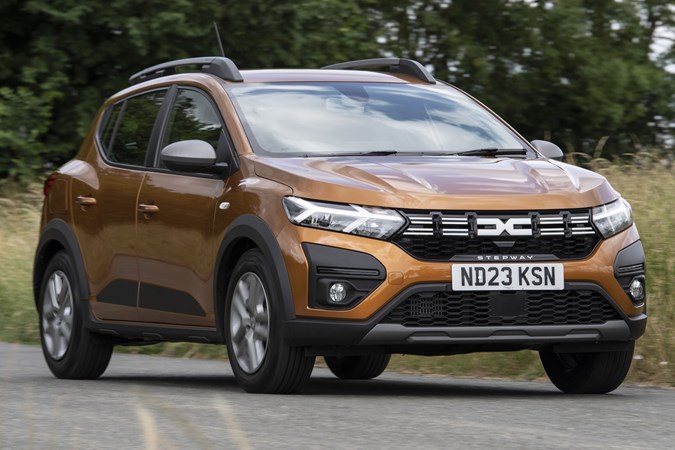
The Parkers long-term test fleet is an ever-shifting quagmire, where family commitments, new hobbies or even just boring old logistics dictate who’s driving what. It was the latter that’s given me custodianship of our Dacia Sandero Stepway.
Now, this might seem a downgrade from the Audi Q5 plug-in hybrid I was running before, but the Sandero is much more of a ‘me’ car. I love Dacia’s no-nonsense approach to motoring, and though my allegiances typically lie more with the larger Duster and Jogger models I was keen to get my teeth stuck into the Sandero Stepway.
I started right away with a baptism of fire, taking it from home in Peterborough 180 degrees around the M25 to Gatwick airport for a car launch. A hellish trip if ever there was one – and with the proliferation of electric vehicles and automatic gearboxes, doing rush hour on the M25 with my left leg active the whole way would be a nice blast from the past.
The Dacia took it all in its stride. As my colleague above has alluded to, the stereo is a little weedy and more subtle songs can be drowned out by the otherwise fairly insubstantial wind and road noise at higher speeds. But apart from that, long journeys in the Sandero Stepway are a-okay. Better than okay, in fact, as the lack of nannying safety aids makes for, I find, a more relaxing journey. Without lane-keeping assist constantly tugging at the wheel, or adaptive cruise control having kittens every time it spots the outline of another car on the horizon, the trip down was stress-free. Plus, the Sandero’s compact enough that parking in Gatwick’s awful short-stay car park was painless.
Soft-roader?
On my way home, I decided to test out the Sandero Stepway’s off-road chops. No, not with rock-crawling in a quarry – changes in elevation aren’t too easy to find in Cambridgeshire at any rate – but with a dusty greenlane that I sometimes take towards my village. Though a treacherous mudpit in the winter, in summer it’s hard-packed and no challenge for any vehicle.

However, the Dacia’s suspension – honed by unmade roads in rural Romania – was amazingly accomplished, and I could easily hold 20mph down there without feeling as though my spine was going to be shaken out of the top of my head. That’s not something you can do in many hatchbacks, or even many SUVs.
A combination of sensibly-sized wheels and tyres, long travel suspension and plenty of ground clearance meant that the lumps and bumps just didn’t bother the car one bit. That, of course, translates to the road, where you can approach speed bumps with gusto and where potholes don’t elicit any panic.
It’s good enough that I’d definitely recommend the Sandero Stepway to anyone who lives rurally – people who don’t necessarily want a hardcore off-roader, but do need their car to cope with the occasional farm track or barely-there driveway.
Update 3: Green around the gills
Our Dacia Sandero Stepway has (rather briefly, for reasons that’ll become clear in this report) changed hands again. This latest driver switch didn’t go smoothly, though.
Report by Luke Wilkinson

The Dacia Sandero Stepway holds a special place in my gut because it’s the first car I’ve ever driven that made me feel car sick as a driver. I used the Stepway to drive several hundred miles to and from various events in the south of England and, after I feared I was going to paint the inside of the windscreen with my lunch on the return journey from an event in Norfolk, I vowed to never set foot in the car again. If I ever failed to keep my stomach in check, I’d be on Dacia’s blacklist quicker than you could say ‘wet vacuum.’
I think my reaction has something to do with the way the Stepway is damped. Its suspension is quite floaty which produces a sensation akin to sea sickness for me. Just like a boat on a rough sea, the view of the horizon out of the Sandero’s windscreen looks level, but you can feel your connection to the earth rocking underneath your backside. I’m convinced it was this clash of cognition that made me feel so green, as the world I was experiencing with my eyes didn’t match with the G-forces I could feel acting on my body. It was very weird.
What’s worse is that I can’t understand why the Sandero Stepway affected me in this way. I’ve always had a cast-iron gut. The last time I was seasick, I was on a ferry between Sweden and Finland sailing through the worst storm the Baltic Sea had seen in a generation. I can also digest blue steak without breaking a sweat, I enjoy smelly cheese and, crucially, I don’t get car sick as a passenger.
I can even (under duress) endure listening to Radio One without jettisoning the contents of my stomach, even though the artists favoured by the network normally possess the same level of musicianship as a truckload of garden furniture being flung down a flight of stairs. That’s digestive strength, that.
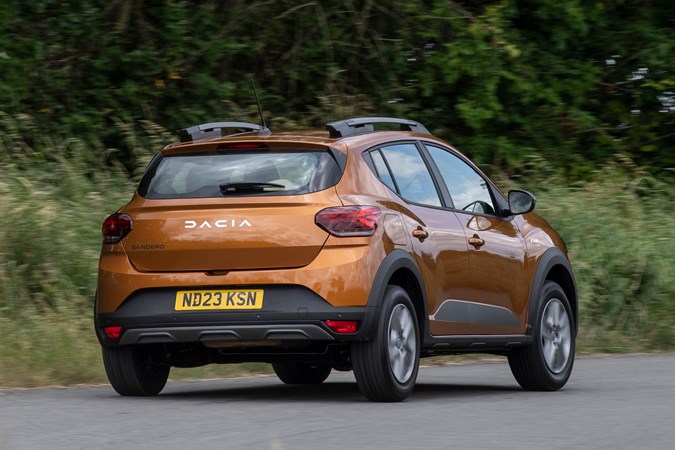
To get a more accurate diagnosis of my condition, I asked my colleagues, Messrs Alan Taylor-Jones and Thomas Wiltshire, to accompany me in the Sandero for a lap of Peterborough. Before I’d reached the end of the dual carriageway leading away from Parkers HQ, the pair of them were in roaring fits of laughter as they gleefully watched the colour drain out of my face. I, meanwhile, was having an intense sparring match with the porridge and coffee I’d savaged for my breakfast.
I’m making light of the situation, but I’m quite disappointed my body rejected the Sandero Stepway. It’s a great little car. Between my acid refluxes, I found it good fun to drive – and the reports above show it’s comfortable on the motorway, tough enough for a spot of soft-roading and surprisingly sprightly considering it’s powered by a dinky 90hp 1.0-litre engine. Factor in its £16,000 price tag (which passes for a steal these days) and you’ve got the makings of the ideal budget runaround.
For the love of whatever deity you worship, though, make sure you secure an extensive test drive before you hand over the cash – especially if you have kids or family members that suffer from car sickness. The cabin is upholstered exclusively in fabric. You have been warned.
| 2023 Dacia Sandero Stepway TCe 90 Expression | |
|---|---|
| Current mileage | 2,450 |
| Real-world average fuel economy | 46 – 48mpg |
| Official combined fuel economy (WLTP figures) | 45.6 – 50.4 mpg |
| Parkers ‘MPP’ (Miles Per Pound) calculation | 6.7 – 7.4 |
| Car joined Parkers fleet | May 2023 |
| Last update: 04 October 2023 |



